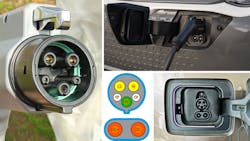An Introduction to the SAE J1772 and CCS EV Charging Interfaces (Download)
The broad adoption of electric vehicles (EVs) depends as nearly as much on the driver’s ability to conveniently access public charging stations as the cost and quality of the vehicles themselves. The success of public networks, in turn, depends on the adoption of a common charging interface that can be used by virtually any EV.
Tesla overcame this problem by aggressively deploying its own fleet of chargers with its own proprietary interface1 throughout the U.S. Meanwhile, other EV manufacturers (and charging services) in the North American market experimented with several competing technologies before finally adopting charging interfaces based on some variant of the SAE J17722,3 standard, or its dc-capable variant, the Combined Charging System (CCS)4.
